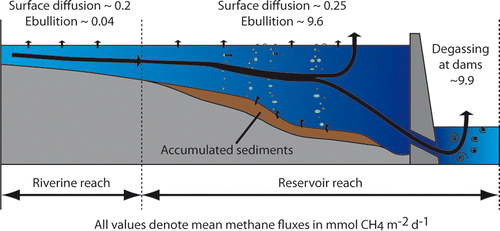Sediment trapped behind dams makes them 'hot spots' for greenhouse gas emissions

With the "green" reputation of large hydroelectric dams already in question, scientists are reporting that millions of smaller dams on rivers around the world make an important contribution to the greenhouse gases linked to global climate change. Their study, showing that more methane than previously believed bubbles out of the water behind small dams, appears in ACS' journal Environmental Science & Technology.
Andreas Maeck and colleagues point out that the large reservoirs of water behind the world's 50,000 large dams are a known source of methane. Like carbon dioxide, methane is one of the greenhouse gases, which trap heat near Earth's surface and contribute to global warming. Methane, however, has a warming effect 25 times more powerful than carbon dioxide. The methane comes from organic matter in the sediments that accumulate behind dams. That knowledge led to questions about hydroelectric power's image as a green and nonpolluting energy source. Maeck's team decided to take a look at methane releases from the water impoundments behind smaller dams that store water less than 50 feet deep.
They describe analysis of methane release from water impounded behind six small dams on a European river. "Our results suggest that sedimentation-driven methane emissions from dammed river hot spot sites can potentially increase global freshwater emissions by up to 7 percent," said the report. It noted that such emissions are likely to increase due to a boom in dam construction fostered by the quest for new energy sources and water shortages.
More information: Sediment Trapping by Dams Creates Methane Emission Hot Spots, Environ. Sci. Technol., Article ASAP. DOI: 10.1021/es4003907
Abstract
Inland waters transport and transform substantial amounts of carbon and account for 18% of global methane emissions. Large reservoirs with higher areal methane release rates than natural waters contribute significantly to freshwater emissions. However, there are millions of small dams worldwide that receive and trap high loads of organic carbon and can therefore potentially emit significant amounts of methane to the atmosphere. We evaluated the effect of damming on methane emissions in a central European impounded river. Direct comparison of riverine and reservoir reaches, where sedimentation in the latter is increased due to trapping by dams, revealed that the reservoir reaches are the major source of methane emissions (0.23 mmol CH4 m–2 d–1 vs 19.7 mmol CH4 m–2 d–1, respectively) and that areal emission rates far exceed previous estimates for temperate reservoirs or rivers. We show that sediment accumulation correlates with methane production and subsequent ebullitive release rates and may therefore be an excellent proxy for estimating methane emissions from small reservoirs. Our results suggest that sedimentation-driven methane emissions from dammed river hot spot sites can potentially increase global freshwater emissions by up to 7%.
Journal information: Environmental Science & Technology
Provided by American Chemical Society



















